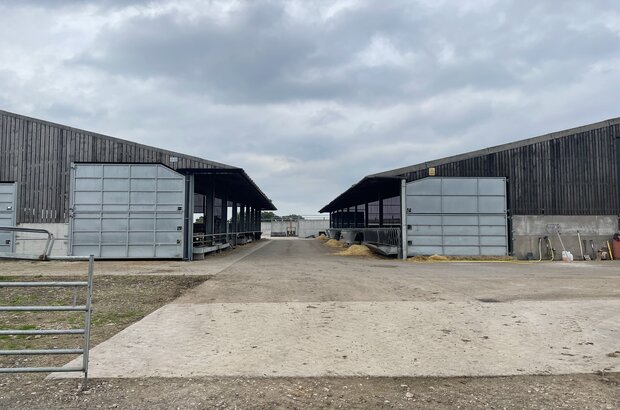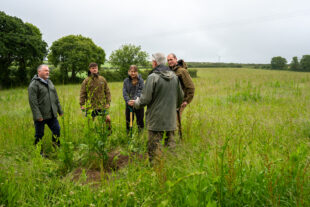
We want to make it easier for farmers to strengthen their businesses. To that end, several changes to permitted development rights are coming into effect from 21 May.
The changes are the result of a consultation undertaken by the Department for Levelling Up, Housing and Communities (DLUHC) between July and September last year.
The consultation sought to understand where additional flexibility could support the agricultural sector. The views of all 977 respondents were considered.
The order that followed, The Town and Country Planning Amendment Order (General Permitted Development, etc) 2024, makes changes to 4 existing permitted development rights that allow for agricultural development and the use change of agricultural buildings.
Permitted development rights are a national grant of planning permission. They provide flexibility and planning freedoms to businesses, local authorities, communities among others.
They support growth and incentivise different types of development by providing certainty and removing the need to spend time and money submitting a planning application.
From 21 May, farmers will no longer be required to submit a planning application for specific types of development.
This includes converting agricultural buildings to a wider range of commercial uses, such as larger farm shops, buildings for agricultural training and sporting facilities.
Use of these permitted development rights remain subject to their existing approvals by the local planning authority. This allows planning matters to be considered in consultation with the local community.
For example, to change agricultural buildings to homes and flexible commercial use, individuals must seek prior approval from the local planning authority for specific issues and risks including transport and flooding.
These prior approvals vary across permitted development rights. For example, to extend or erect agricultural buildings, individuals must seek approval for the building's design and external appearance instead.
A third of all farmland is managed by tenant farmers and we recognise the importance of tenanted holdings being able to access the opportunities that these planning changes provide. Tenant Farmers should check the terms of their tenancy agreement and consult with their landlord on any proposals they may have to use these changes to permitted development rights.
We encourage all tenants and landlords to follow the recently launched Agricultural Landlord and Tenant Code of Practice which promotes clarity, communication and collaboration in the tenanted sector.
The code sets out guidance for tenants and landlords to discuss new schemes and diversification opportunities openly and constructively.
Further detail on the changes
We are extending existing permitted development rights to give farmers greater flexibility to convert agricultural buildings to commercial uses.
The changes will allow farmers to convert larger buildings to a wider range of uses.
We are also allowing for larger agricultural buildings and extensions to be erected, allowing farmers to respond to changing agricultural practices.
In addition to this, we are extending permitted development rights so farmers can use agricultural buildings to process raw goods produced on site and which are to be sold on site (excluding livestock) and we are allowing them to develop and extend larger buildings for agricultural purposes.
Finally, we are allowing farmers to convert buildings on agricultural units and former agricultural buildings to a larger number of homes, more suited to rural needs.
Increased floorspace
The amount of floorspace that can change from agricultural use to ‘flexible commercial use’ will increase from 500 square metres to 1,000 square metres.
The amount of floorspace that can change from a building on an agricultural unit and a former agricultural building to a home will increase from 865 square metres to 1,000 square metres.
Wider range of commercial building uses
The range of uses agricultural buildings and land within their curtilage can be used for will widen. This will fall under ‘flexible commercial use’ to include:
- the processing of raw goods produced on the site and which are to be sold on the site (excluding livestock)
- the provision of agricultural training
- outdoor sports, recreation and fitness uses within the curtilage of an agricultural building.
Changes to agricultural buildings
We are also increasing the ground area limit of new buildings or extensions erected on farms over 5 hectares in size from 1,000 square metres to 1,500 square metres.
For farms under 5 hectares in size we are increasing the ground area limit for extensions to existing agricultural buildings from 1,000 square metres to 1,250 square metres.
We are also increasing the cubic content limit of an agricultural building. This will extend from 20% to 25% above the original building cubic content.
Supporting rural housing
To encourage conversion of agricultural buildings to more homes suited to rural needs, we are introducing a single maximum floorspace per house limit of 150 square metres.
We are also allowing up to 10 homes (increased from 5) to be delivered and allowing up to 1,000 square metres of floorspace to change use overall.
Housing delivered through this right must meet the national space standard and receive prior approval from the local planning authority that they have adequate natural light.
Individuals cannot use this permitted development right in protected landscapes (this includes National Parks and National Landscapes). However the other rights can be used in protected landscapes.
Scheduled monuments
We are removing the ability for extensions and the erection of new buildings where there is a designated scheduled monument, to ensure that these nationally important monuments are preserved for the benefit of current and future generations.
Next steps
Subject to the agreement of Parliament, these permitted development rights will be available after secondary legislation (law created by ministers or other bodies under powers given to them by an Act of Parliament) comes into force on 21 May 2024.
Colleagues at DLUHC will continue to monitor permitted development rights. They will make changes in order to ensure that the intended outcomes are achieved.
Recognising the importance of the food and farming sector to our nation, the Prime Minister will host the second UK Farm to Fork Summit at 10 Downing Street on 14 May. This event will bring together industry across the food supply chain to explore further opportunities to support the sector.
Learn more
The amendments deliver on one of the pledges made by the Prime Minister at the Farm to Fork Summit in May last year, to cut red tape and streamline the planning system for farmers. Learn more about the pledges.




44 comments
Comment by Barrie Crowther posted on
Hi, Under the new rules can a house / bungalow be built within the farm building boundary for a son / daughter to take over from their aged parents ? Just so long as it falls below the 150 sq mt limit.
Comment by Sarah Stewart posted on
Hi Barrie,
This document (from 5.4 onwards) might help: https://www.legislation.gov.uk/uksi/2024/579/pdfs/uksiem_20240579_en_001.pdf
Best wishes,
Sarah
Comment by Mariesol Tregonwell-Monro-Smith posted on
Good timing for release of impending statutory instrument
Comment by Claire K posted on
Does this included listed buildings as I have a derelict structure on my land which is falling to bits but my aunt put in to get it listed as she is emotionally attached to the family farm so I have been struggling to get planning as the restrictions were so high
Comment by Sarah Stewart posted on
Hi Claire,
The Planning Practice Guidance includes a link to information on listed buildings: https://www.gov.uk/guidance/when-is-permission-required#a-flexible-use
Best wishes,
Sarah
Comment by Ian Hemingway posted on
Does this change apply to farms that have already diversified into equestrian businesses or do the land/buildings have to be used solely for agricultural use to be able to use permitted development rights?
Comment by Sarah Stewart posted on
Hi Ian,
Amendment of Class Q of Part 3 goes into more detail: https://www.legislation.gov.uk/uksi/2024/579/made
Best wishes,
Sarah
Comment by Joanne Mitchem posted on
We have a farm with 3 pole barns sheds etc. The problem is that it’s in Sevenoaks District council area .Green belt area of outstanding natural beauty. Having recently been refused permission for 3 self build homes.
Would this change today to help farmers help us in any way. As nearly all this area in green belt Sevenoaks continually refuses permission.
Comment by Sarah Stewart posted on
Hi Joanne,
Only local authorities or the Secretary of State can give permission for development in, or affecting, an AONB. This information and more detail, can be found on GOV.UK: https://www.gov.uk/guidance/areas-of-outstanding-natural-beauty-aonbs-designation-and-management#development
Best wishes,
Sarah
Comment by Andy posted on
What about protected species surveys? Who will check for this at the council?
Comment by Claire posted on
What about Wales? Is it different there?
Comment by Sarah Stewart posted on
Hi Claire,
This extends to England and Wales (see section c under the 'Citation, commencement and extent' section ohttps://www.legislation.gov.uk/uksi/2024/579/made)
Best wishes,
Sarah
Comment by Hardy Klindt posted on
Does the change of use to a dwelling only apply to any agricultural building or must they be over a certain age ?
Comment by Sarah Stewart posted on
Hello,
You can read more in the General Permitted Development Order https://www.legislation.gov.uk/uksi/2024/579/made and Planning Practice Guidance. https://www.gov.uk/guidance/when-is-permission-required#a-flexible-use
Best wishes,
Sarah
Comment by Jamie Strong posted on
Hello about 9 months ago I submitted a 28 day notice for permitted development on a new agricultural and Forrestry barn on our smallholding . Teignbridge council rejected it and said it would have to go to full planning and could take up to 2 years to get a decision .they rejected the barn on permitted development due to the application being under 2 titles agriculture and Forrestry is this correct ? Thanks Jamie
Comment by The Team posted on
Hi Jamie,
We're afraid we can't comment on specific planning considerations or applications.
You can read more in the General Permitted Development Order https://www.legislation.gov.uk/uksi/2024/579/made and Planning Practice Guidance. https://www.gov.uk/guidance/when-is-permission-required#a-flexible-use
Best wishes,
The Team
Comment by William taylor posted on
Does this mean you can erect a new building for commercial use like a farm shop without planning ?
Comment by Sarah Stewart posted on
Hi William,
The planning guidance around farm shops can be found here: https://www.gov.uk/guidance/when-is-permission-required#a-flexible-use
Best wishes,
Sarah
Comment by David chambers posted on
Are these new rules now confirmed and in place?
Comment by Sarah Stewart posted on
Hi David,
Yes. The details are here: https://www.legislation.gov.uk/uksi/2024/579/made
Best wishes,
Sarah
Comment by Harry posted on
Under the new rights are we able to re orientate two buildings with the same floor layout and profile within the already agreed red edge of the farm yard so as to better deal with prevailing weather conditions without applying for permission?
Comment by Sarah Stewart posted on
Hi Harry,
Linking to this page on GOV.UK which should help: https://www.gov.uk/guidance/when-is-permission-required#permitted-development-rights
Best wishes,
Sarah
Comment by Paul Bailey posted on
Does this ruling apply to small holdings of say 5 to 6 acres with existing structures?
Comment by Sarah Stewart posted on
Hi Paul,
The guidance can be found here: https://www.gov.uk/guidance/when-is-permission-required#permitted-development-rights
Best wishes,
Sarah
Comment by Alan Tittensor posted on
Hi, A colleague of mine (not a farmer) owns a converted barn, which they live in, and has an old farm outbuilding on the land.
Does this mean they will be able to demolish the old farm building/unit and build a domestic property in its place, under permitted development, probably to sell?
Comment by The Team posted on
Hi Alan,
We're afraid we cannot comment on specific planning considerations or applications.
You can read more in the General Permitted Development Order https://www.legislation.gov.uk/uksi/2024/579/made and Planning Practice Guidance. https://www.gov.uk/guidance/when-is-permission-required#a-flexible-use
Best wishes,
The Team
Comment by Ian Travell posted on
No changes to what you can do with agricultural land then. We have acres and acres of fields that we can do nothing with. We don’t farm it but also aren’t allowed to reclassify it to domestic. Meaning it’s pretty much useless. Planning permission is a total nightmare. Planning officers having so much control over your property is madness and planning needs to be overhauled.
Comment by Barbara Everett posted on
Hello, can you point me in the right direction for any new guidance for ag land under 5 hectares?
Thanks
Comment by Sarah Stewart posted on
Hi Barbara,
You can read more in the General Permitted Development Order: https://www.legislation.gov.uk/uksi/2024/579/made
and
Planning Practice Guidance: https://www.gov.uk/guidance/when-is-permission-required#permitted-development-rights
Best wishes,
Sarah
Comment by Deborah Howarth posted on
Do restrictions such as green belt, rivers and valleys, conservation area, area of natural beauty etc mean that the new rules will not apply?
Comment by Sarah Stewart posted on
Hi Deborah,
There is a range of exclusions which apply to certain permitted development rights in England. For instance, there are protected areas known as article 2(3) land, which cover:
-conservation areas
-Areas of Outstanding Natural Beauty
-National Parks
-the Broads
-World Heritage Sites
There are other land areas known as article 2(4) land. Article 2(4) land covers land within a National Park, the Broads or certain land outside the boundaries of a National Park.
This information is on GOV.UK: https://www.gov.uk/guidance/when-is-permission-required#permitted-development-rights
This link will take you to the General Permitted Development Order: https://www.legislation.gov.uk/uksi/2024/579/made
Best wishes,
Sarah
Comment by Graeme Lamb posted on
Hi I have owned a small holding with in suburbia on the edge of a country park since mid 1980's. I own the yard and buildings (freehold) but am a tenant on all grass land. Originally I was responsible for 150+ acres and had cattle/sheep and horses, using all the grass land to make hay. Over the years the land has been whittled down by developments and local authority conservation areas to 28 acres and I'm due to loose more this Nov. There is now also a new development of 147 homes 200mtrs away from the yard . It only has one road leading to it past my gates and no other access is planned, The road which was once quiet has now become like the A1. It is becoming increasingly impossible and dangerous to run a agricultural business here. The buildings here are unsuitable for conversion . Would this new legislation allow me to remove all the buildings and build new homes or create a small industrial estate. I live on site in a chalet and pay council tax
Comment by The Team posted on
Hello Graeme,
We're afraid we can't comment on specific planning considerations or applications.
You can read more in the General Permitted Development Order https://www.legislation.gov.uk/uksi/2024/579/made and Planning Practice Guidance. https://www.gov.uk/guidance/when-is-permission-required#a-flexible-use
Best wishes,
The Team
Comment by Alan Broadbent posted on
Hi Claire, I purchased approximately 0.5 acre of land from Railtrack in 2000 the land had in 1969 a agricultural tenancy agreement which must ended prior to purchase I have a demarcation agreement from the Railtack which state's in a Easement I have the right to "erect or suffer to erect at anytime any buildings or other erections" in the easement, A FOI supplied the deed from when the railway acquired the land in 1845 the deed shows there is an additional area of land which would take it over 0.4Ha. The T&C Act 1990 S 263/264 identify the land as Operational land could you suggest what permitted development rights I may use or what the easement indicates
Comment by The Team posted on
Hello Alan,
We're afraid we can't comment on specific planning considerations or applications.
You can read more in the General Permitted Development Order https://www.legislation.gov.uk/uksi/2024/579/made and Planning Practice Guidance. https://www.gov.uk/guidance/when-is-permission-required#a-flexible-use
Best wishes,
The Team
Comment by peter corthorn posted on
Hello,
We have a 10.5 acre (2 acres under 5 hectares) smallholding, and we really need to build an open-sided drying shed to dry our coppiced willow which fuels our home.
Do the new changes to permitted development mean that we can do this if the measurements are within the range, or do we still need to have 5 hectares to qualify? It seems unclear if any of the changes give any more help to smallholders, other than the right to extend existing buildings...?
Thanks, Anybody
Comment by The Team posted on
Hello Peter,
We're afraid we can't comment on specific planning considerations or applications.
You can read more in the General Permitted Development Order https://www.legislation.gov.uk/uksi/2024/579/made and Planning Practice Guidance. https://www.gov.uk/guidance/when-is-permission-required#a-flexible-use
Best wishes,
The Team
Comment by Tsc posted on
Is this likely to be extended to the national parks
Comment by Sarah Stewart posted on
Hello,
There is a range of exclusions which apply to certain permitted development rights in England. For instance, there are protected areas known as article 2(3) land, which cover:
conservation areas
Areas of Outstanding Natural Beauty
National Parks
the Broads
World Heritage Sites
There are other land areas known as article 2(4) land. Article 2(4) land covers land within a National Park, the Broads or certain land outside the boundaries of a National Park.
This information can be found on GOV.UK: https://www.gov.uk/guidance/when-is-permission-required#permitted-development-rights
Best wishes,
Sarah
Comment by stephen posted on
Hi what about wind turbines and connection to grid
as i understand the height restriction has been lifted to 30 meters do i need to make a prior approval application
or does this come under a different category in respect of planning , or in fact is any form of planning needed,
particularly if not connected to grid.
Or in fact solar panels fitted to either buildings or free standing
Kind regards stephen
Comment by The Team posted on
Hi Stephen,
Here's a link to the planning information on solar and wind technology:
https://www.gov.uk/guidance/renewable-and-low-carbon-energy
Best wishes,
The Team
Comment by Debra Glover posted on
If I want to build a new shed to store farm machinery in would I need planning permission under these new rules? It's not a big building, under 200m squared.Thanks for any help you can offer
Comment by Sarah Stewart posted on
Hi Debra,
Here's a link to the Planning Practice Guidance: https://www.gov.uk/guidance/when-is-permission-required
Best wishes,
Sarah
Comment by jeannie Gee posted on
I am wondering if the above relation of planning and building control would permit the erection of a steel frame building for general farm use. A local farm to us told us he was about to. (make things easier within the farm) by putting up this new building which he has now started, but I cannot see where this could be permitted without some sort of building control, at the present time it isnt joined onto on of his 8 large buildings.